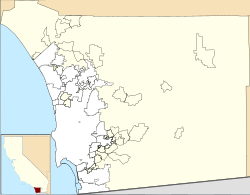
| Otay Mountain | |
|---|---|
 Otay Mountain as seen from Doghouse Junction | |
| Highest point | |
| Elevation | 3,568 ft (1,088 m) NAVD 88 NAVD 88 [1] |
| Prominence | 2,086 ft (636 m) [2] |
| Coordinates | 32°35′40″N116°50′41″W / 32.594567222°N 116.844671506°W [1] |
| Geography | |
| Location | San Diego County, California |
| Parent range | San Ysidro Mountains |
| Topo map | USGS Otay Mountain |
| Climbing | |
| Easiest route | Trail hike (Class 1) [3] |
Otay Mountain is a mountain in San Diego County, California. It is the highest summit of the San Ysidro Mountains. The mountain is located in the Otay Mountain Wilderness area. [3]
The Mexico-United States border runs along the south face of the mountain.


